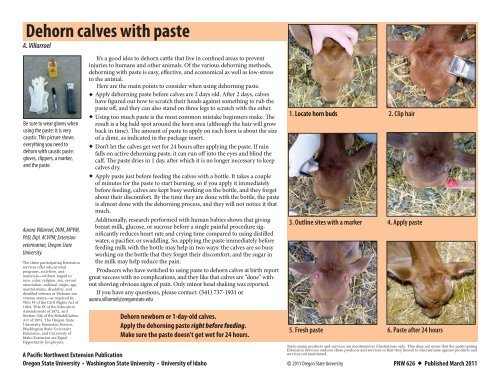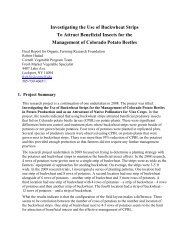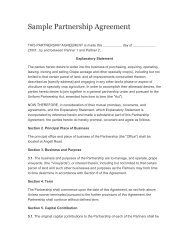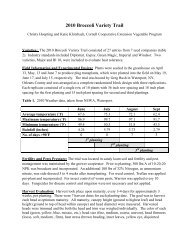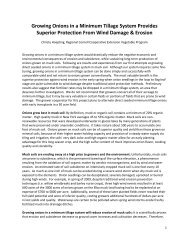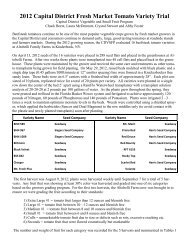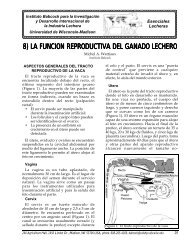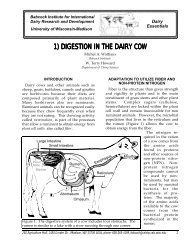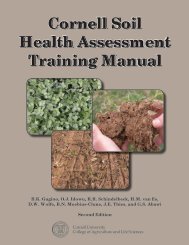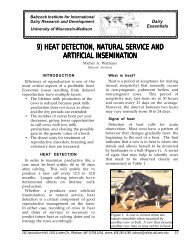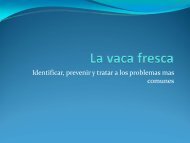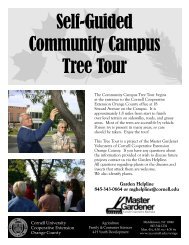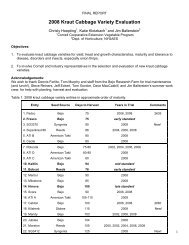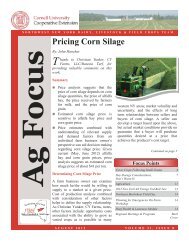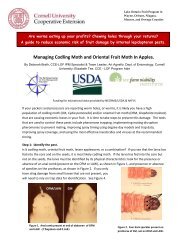Dehorn calves with paste - Oregon State University
Dehorn calves with paste - Oregon State University
Dehorn calves with paste - Oregon State University
Create successful ePaper yourself
Turn your PDF publications into a flip-book with our unique Google optimized e-Paper software.
<strong>Dehorn</strong> <strong>calves</strong> <strong>with</strong> <strong>paste</strong><br />
A. Villarroel<br />
Be sure to wear gloves when<br />
using the <strong>paste</strong>: it is very<br />
caustic. This picture shows<br />
everything you need to<br />
dehorn <strong>with</strong> caustic <strong>paste</strong>:<br />
gloves, clippers, a marker,<br />
and the <strong>paste</strong>.<br />
Aurora Villarroel, DVM, MPVM,<br />
PhD, Dipl. ACVPM; Extension<br />
veterinarian, <strong>Oregon</strong> <strong>State</strong><br />
<strong>University</strong>.<br />
The three participating Extension<br />
services offer educational<br />
programs, activities, and<br />
materials—<strong>with</strong>out regard to<br />
race, color, religion, sex, sexual<br />
orientation, national origin, age,<br />
marital status, disability, and<br />
disabled veteran or Vietnam-era<br />
veteran status—as required by<br />
Title VI of the Civil Rights Act of<br />
1964, Title IX of the Education<br />
Amendments of 1972, and<br />
Section 504 of the Rehabilitation<br />
Act of 1973. The <strong>Oregon</strong> <strong>State</strong><br />
<strong>University</strong> Extension Service,<br />
Washington <strong>State</strong> <strong>University</strong><br />
Extension, and <strong>University</strong> of<br />
Idaho Extension are Equal<br />
Opportunity Employers.<br />
It’s a good idea to dehorn cattle that live in confined areas to prevent<br />
injuries to humans and other animals. Of the various dehorning methods,<br />
dehorning <strong>with</strong> <strong>paste</strong> is easy, effective, and economical as well as low-stress<br />
to the animal.<br />
Here are the main points to consider when using dehorning <strong>paste</strong>.<br />
Apply dehorning <strong>paste</strong> before <strong>calves</strong> are 2 days old. After 2 days, <strong>calves</strong><br />
have figured out how to scratch their heads against something to rub the<br />
<strong>paste</strong> off, and they can also stand on three legs to scratch <strong>with</strong> the other.<br />
Using too much <strong>paste</strong> is the most common mistake beginners make. The<br />
result is a big bald spot around the horn area (although the hair will grow<br />
back in time). The amount of <strong>paste</strong> to apply on each horn is about the size<br />
of a dime, as indicated in the package insert.<br />
Don’t let the <strong>calves</strong> get wet for 24 hours after applying the <strong>paste</strong>. If rain<br />
falls on active dehorning <strong>paste</strong>, it can run off into the eyes and blind the<br />
calf. The <strong>paste</strong> dries in 1 day, after which it is no longer necessary to keep<br />
<strong>calves</strong> dry.<br />
Apply <strong>paste</strong> just before feeding the <strong>calves</strong> <strong>with</strong> a bottle. It takes a couple<br />
of minutes for the <strong>paste</strong> to start burning, so if you apply it immediately<br />
before feeding, <strong>calves</strong> are kept busy working on the bottle, and they forget<br />
about their discomfort. By the time they are done <strong>with</strong> the bottle, the <strong>paste</strong><br />
is almost done <strong>with</strong> the dehorning process, and they will not notice it that<br />
much.<br />
Additionally, research performed <strong>with</strong> human babies shows that giving<br />
breast milk, glucose, or sucrose before a single painful procedure significantly<br />
reduces heart rate and crying time compared to using distilled<br />
water, a pacifier, or swaddling. So, applying the <strong>paste</strong> immediately before<br />
feeding milk <strong>with</strong> the bottle may help in two ways: the <strong>calves</strong> are so busy<br />
working on the bottle that they forget their discomfort, and the sugar in<br />
the milk may help reduce the pain.<br />
Producers who have switched to using <strong>paste</strong> to dehorn <strong>calves</strong> at birth report<br />
great success <strong>with</strong> no complications, and they like that <strong>calves</strong> are “done” <strong>with</strong>out<br />
showing obvious signs of pain. Only minor head shaking was reported.<br />
If you have any questions, please contact: (541) 737-1931 or<br />
aurora.villarroel@oregonstate.edu<br />
<strong>Dehorn</strong> newborn or 1‐day‐old <strong>calves</strong>.<br />
Apply the dehorning <strong>paste</strong> right before feeding.<br />
Make sure the <strong>paste</strong> doesn’t get wet for 24 hours.<br />
A Pacific Northwest Extension Publication<br />
<strong>Oregon</strong> <strong>State</strong> <strong>University</strong> • Washington <strong>State</strong> <strong>University</strong> • <strong>University</strong> of Idaho<br />
1. Locate horn buds 2. Clip hair<br />
3. Outline sites <strong>with</strong> a marker 4. Apply <strong>paste</strong><br />
5. Fresh <strong>paste</strong> 6. Paste after 24 hours<br />
Trade-name products and services are mentioned as illustrations only. This does not mean that the participating<br />
Extension Services endorse these products and services or that they intend to discriminate against products and<br />
services not mentioned.<br />
© 2011 <strong>Oregon</strong> <strong>State</strong> <strong>University</strong><br />
PNW 626 Published March 2011
Descornar terneras con pasta<br />
A. Villarroel<br />
Asegúrese de usar guantes<br />
cuando use la pasta porque<br />
es muy cáustica. En la foto<br />
aquí adjunta puede ver<br />
todo el material necesario<br />
para descornar con la pasta<br />
descornadora: guantes, una<br />
afeitadora, un rotulador y<br />
la pasta.<br />
Aurora Villarroel, DVM, MPVM,<br />
PhD, Dipl. ACVPM; Extension<br />
veterinarian, <strong>Oregon</strong> <strong>State</strong><br />
<strong>University</strong>.<br />
The three participating Extension<br />
services offer educational<br />
programs, activities, and<br />
materials—<strong>with</strong>out regard to<br />
race, color, religion, sex, sexual<br />
orientation, national origin, age,<br />
marital status, disability, and<br />
disabled veteran or Vietnam-era<br />
veteran status—as required by<br />
Title VI of the Civil Rights Act of<br />
1964, Title IX of the Education<br />
Amendments of 1972, and<br />
Section 504 of the Rehabilitation<br />
Act of 1973. The <strong>Oregon</strong> <strong>State</strong><br />
<strong>University</strong> Extension Service,<br />
Washington <strong>State</strong> <strong>University</strong><br />
Extension, and <strong>University</strong> of<br />
Idaho Extension are Equal<br />
Opportunity Employers.<br />
El descornado de ganado que vive en corrales es importante para prevenir<br />
heridas a personas y otros animales. De los métodos de descuerne que hay, la<br />
pasta descornadora es el método mas fácil. Además produce poco estrés en<br />
las terneras y es barato, a la vez que efectivo.<br />
Tenga en cuenta los siguientes puntos a la hora de usar la pasta descornadora:<br />
Aplique la pasta antes de los 2 días de edad. Después de 2 días, las terneras<br />
aprenden como rascarse la cabeza contra algo, y a pararse sobre 3 patas<br />
para rascarse la cabeza con la otra. Por tanto, descornar antes de los 2 días<br />
de vida es la mejor forma de evitar que se rasquen la pasta.<br />
El error mas común de gente que empieza a usar la pasta es usar demasiada,<br />
lo que resultará en un área grande sin pelo, aunque volverá a crecer<br />
después de unos meses. La cantidad de pasta a aplicar es equivalente a una<br />
moneda de diez centavos, como dice en el prospecto del paquete.<br />
No deje que las terneras se mojen durante 24 horas después de aplicar la pasta.<br />
Si llueve sobre la pasta fresca, se puede correr hacia los ojos de la ternera y<br />
dejarla ciega. La pasta se seca en un día, así que solamente hace falta tener<br />
cuidado con la lluvia durante el primer día después de aplicar la pasta.<br />
Aplique la pasta justo antes de alimentar a las terneras con la mamila. La<br />
pasta tarda un par de minutos en empezar a quemar, de forma que aplicando<br />
la pasta justo antes de dar la mamila hará que se concentren en la<br />
mamila y se olviden de la molestia que causa la pasta al quemar el cuerno.<br />
Para cuando terminen de mamar, la pasta prácticamente ha terminado de<br />
descornar y no les molestará tanto.<br />
Además, estudios hechos en bebes humanos demuestran que dándoles<br />
leche materna o azúcar cuando se hace un procedimiento doloroso reduce<br />
el pulso y el tiempo que lloran comparado con darles agua destilada o<br />
la chupeta. Por tanto, aplicando la pasta justo antes de darles la leche a<br />
las terneras con la mamila puede ayudar de dos formas: haciendo que se<br />
concentren en mamar en vez de la molestia de los cuernos, y el azúcar de<br />
la leche puede ayudar a disminuir la sensación de dolor.<br />
Ganaderos que han cambiado a usar la pasta descornadora en terneras<br />
recién nacidas están muy contentos y no han visto complicaciones. Además<br />
les gusta que las terneras estén «hechas» sin dar señales evidentes de dolor.<br />
Sólo se reportan movimientos mínimos de cabeza.<br />
Si tiene preguntas, no dude en ponerse en contacto conmigo:<br />
(541) 737‐1931 o aurora.villarroel@oregonstate.edu<br />
Descuerne terneras recién nacidas o de 1 día<br />
Aplique la pasta justo antes de darles la leche<br />
Asegúrese que la pasta no se moje durante 24 horas<br />
A Pacific Northwest Extension Publication<br />
<strong>Oregon</strong> <strong>State</strong> <strong>University</strong> • Washington <strong>State</strong> <strong>University</strong> • <strong>University</strong> of Idaho<br />
1. Localice los cuernos 2. Quite el pelo<br />
3. Marque la zona con rotulador 4. Aplique la pasta<br />
5. Pasta recién aplicada 6. Pasta tras 24 horas<br />
Nombres comerciales y servicios mencionados aquí son usados solamente como ejemplos. Esto no significa<br />
que los Serviciosde Extensión participantes endorsen estos productos o servicios, o que tengan intención de<br />
discriminar en contra de aquellos productoso servicios no mencionados.<br />
© 2011 <strong>Oregon</strong> <strong>State</strong> <strong>University</strong><br />
PNW 626 Publicado en marzo 2011


